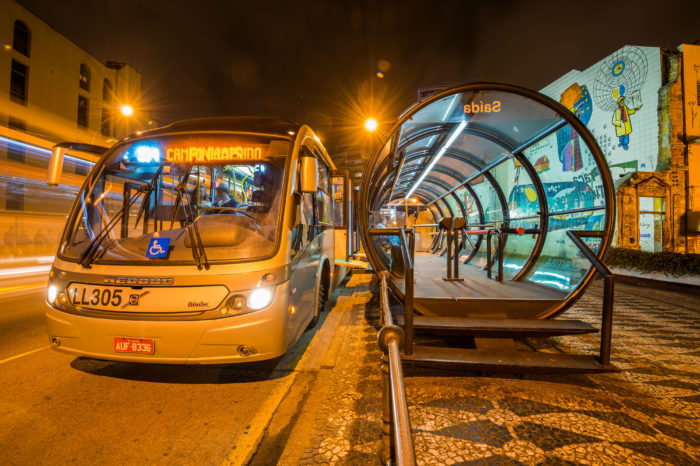Lessons Learned during Summer Travels: BRT in Curitiba, Brazil
Boston is a city with rich history, vibrant cultural traditions, influential and prestigious academic institutions, and wildly successful sports teams. It is a city with much to be proud of. However, it is also a city with much to improve upon, but some models for improvement lie in cities with vastly different attributes.
Take, for example, Curitiba, in southern Brazil. The city of nearly 2 million inhabitants has been internationally recognized as a beacon of sustainability for a host of reasons, including its wealth of green spaces, pedestrian-friendly areas and notably, its groundbreaking mass transit initiatives.
Curitiba is lauded as the birthplace of Bus Rapid Transit (BRT). Introduced in the city beginning in 1974 by innovative Mayor Jaime Lerner, who oversaw several reforms which have contributed to the city becoming the model of effective city planning it is today, BRT corridors represent a cost-effective alternative to a traditional underground subway line. BRT is characterized by features such as dedicated bus lanes to help provide right of way and avoid traffic, along with covered and elevated stations where fares are collected prior to boarding and boarding takes place from platforms situated on the same level as the buses in order to streamline and speed up the process.
In Curitiba, bus services are run entirely by private companies which are paid by distance traveled, not passenger volume, which helps discourage congestion. Over time, the program has been wildly successful, with ridership increasing by 400 percent over its first 20 years in existence and every private bus contractor operating at a profit. The people of Curitiba have made great use of what has been made available to them, with 60 percent of overall travel in the city coming by bus.
The Institute for Transportation & Development Policy (ITDP) has outlined the qualifying features of BRT as part of a rating system it calls the BRT Standard, which rates BRT plans worldwide as Bronze, Silver, or Gold. Curitiba’s transit corridor has earned a Gold rating from the ITDP.
If it worked so well in southern Brazil, why not here in Boston?
As Pioneer has previously covered and suggested in greater detail, BRT could be a viable alternative to some of the problematic transit initiatives currently being undertaken in Boston by the MBTA. Given the host of issues and massive costs that have become associated with the Green Line Extension (GLX), for example, the MBTA may want to consider whether installing new BRT corridors may work out better than the seemingly ill-fated GLX. BRT has long been popular in cities across Latin America and Southeast Asia, but has recently begun to catch on in the United States, with a notable example being the successful implementation of a corridor in Cleveland, Ohio. The MBTA has already formed a BRT Study Group with assistance from the ITDP, which has identified five potential areas in Boston through which BRT corridors could potentially help cut commute times significantly. Perhaps most importantly given the MBTA’s well-publicized financial troubles, the BRT Study Group also conducted an installation and maintenance cost comparison which came to the following conclusion: “BRT can be seven times more affordable than light rail, per mile. That’s 25 miles of BRT infrastructure for the same cost of less than four miles of light rail.” These numbers are quite jarring, especially given the financial quagmire the Green Line Extension has become.
As can be seen in Curitiba and elsewhere, BRT is a great model to follow for cities looking to improve their mass transit infrastructure while cutting costs. It would seem that Boston is a fantastic candidate to implement such a system, and it is highly encouraging that the MBTA has already created a Study Group to look into the possibility. In fact, BRT in Boston has already been pursued going back several years. The MBTA’s Silver Line does have some BRT features, but its lack of pre-boarding fare payments or a dedicated lane throughout its route prevent it from receiving a Bronze rating from the ITDP. Additionally, in 2009, a proposal to install BRT service on Route 28 was rejected after some pushback from community groups in Roxbury and Mattapan, but that should not discourage the agency from continuing to pursue BRT as an option in the future. The Route 28 project’s failure can largely be attributed to a poor effort by the state in educating residents about the initiative, which is a very fixable problem.
The MBTA can take a lesson from former Curitiba Mayor Lerner and think a little bit more outside the box in its effort to improve Boston’s transportation outlook moving forward.
Michael Weiner is a senior at Northeastern University studying International Affairs. He began working at Pioneer Institute through the Northeastern Co-op program and has continued as a Research Assistant. Find Michael on Twitter at: @michaelgweiner



